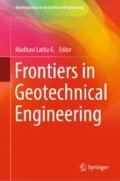Abstract
Design of heavily loaded foundations for tall buildings requires a realistic assessment of the design parameters. A comprehensive geotechnical investigation and in situ tests such as static cone penetrometer tests, pressure meter tests, and cross-hole seismic tests in addition to deep boreholes can provide the inputs for selection of the design profile. The piled-raft concept can yield substantial saving in the design of tall buildings by reducing the number of piles due to the contribution of the intervening soils below the raft. To assess the settlement and load distribution beneath the raft, soil–structure interaction study should be done. A case study of a 38-storeyed building in the Indo-Gangetic Alluvium is presented to demonstrate the quality of data that can be obtained from a thorough geotechnical investigation and to illustrate the concept of piled raft. While the reliability of the design is enhanced, the savings that can be achieved by such an approach can be substantial.
Access this chapter
Tax calculation will be finalised at checkout
Purchases are for personal use only
References
IS: 16700: Criteria for structural safety of tall concrete buildings. Bureau of Indian Standards, New Delhi (2017)
Council on Tall Buildings and Urban Habitat. http://www.ctbuh.org/TallBuildings/HeightStatistics/Criteria/tabid/446/language/en-US/Default.aspx
Quick, H., Meissner, S., Michael, J.: Innovative foundation systems for high-rise buildings. In: Proceedings, 1st Intelligent Building Middle East Conference, Bahrain (2015)
Poulos, H.G., Badelow, F.: Geotechnical parameter assessment for tall building design. Int. J. High-Rise Build. 4(4), 227–239 (2015)
Sundaram, R.: Geotechnical investigations in difficult ground conditions—Indian experiences. In: Sixth Madhav Lecture, Proceedings, GeoPractices-2017, IGS Hyderabad (2017)
IS: 1893 Part-1: Criteria for earthquake resistant design of structures. Bureau of Indian Standards, New Delhi (2016)
Youd, T.L., Idriss, I.M.: Liquefaction resistance of soils: Summary report from the 1996 NCEER and 1998 NCEER/NSF workshops on evaluation of liquefaction resistance of soils. J. Geotech. Geo-environ. Eng. 297–313 (2001)
Haberfield, C.M.: Practical experience in piled-raft design for tall buildings. In: Proceedings, 18th ICSMGE, Paris (2013)
Gupta, S., Sundaram, R.: In-situ testing-current trends in geotechnical investigations. In: Proceedings, Indian Geotechnical Conference, IGC-2003. Roorkee, pp. 635–645 (2003)
Katzenbach, R., Arslan, U., Moormann, C.: Piled raft foundation in Germany. In: Hemsley, J.A. (ed.), Design Applications of Raft Foundations. London, Thomas Telford Ltd, pp. 323–391 (2000)
Poulos, H.G.: Piled raft foundations: design and application. Geotechnique, 51(2), 95–113 (2001)
de Sanctis, L., Mandolini, A.: Bearing capacity of piled rafts on soft clay soils. J. Geotech. Geoenviron. Eng. 132(12), 1600–1610 (2006)
Amornfa, K., Phienwej, N., Kitpayuck, P.: Current practice on foundation design of high rise buildings in Bangkok, Thailand. J. Lowland Technol. Int. 14(2), 70–83 (2012)
Vaidya, R., Likins, G.: Guidelines for successful high-strain dynamic load tests and low strain integrity tests for bored piles. In: Proceedings, DFI-India-2013, Mumbai (2013)
Osterberg, J.: New device for load testing driven and drilled shafts separates friction and end bearing. In: Proceedings International Conference Piling and Deep Foundations, London, pp. 421–427 (1989)
George, J.S., Sundaram, R., Gupta, S.: Bi-directional static load tests—case studies. In: Proceedings DFI-India 2018, Gandhinagar, paper communicated (2018)
Gupta, S., Sundaram, R., Gupta, S.: Footing load tests on sand: validating theoretical predictions. In: Proceedings, Indian Geotechnical Conference-IGC-2016, Chennai (2016)
Haberfield, C.M.: Practical application of soil structure interaction analysis. In: Gregory Tschebotarioff Lecture, Proceedings, 19th ICSMGE, vol. 1. Seoul, Korea, pp. 83–101 (2017)
IS: 1904-1986 Reaffirmed: Design and construction of foundations in soils: general requirements. Bureau of Indian Standards, New Delhi (2006)
IS: 12070-1987 Reaffirmed: Design and construction of shallow foundations on rock. Bureau of Indian Standards, New Delhi (2010)
Zhang, L., Ng, A.M.Y.: Limiting tolerable settlement and angular distortion for building foundations. Geotechnical Special Publication No. 170, Probabilistic Applications in Geotechnical Engineering, ASCE (2006)
IS: 2911 Part 4: Design and construction of pile foundations—code of practice part 4 load test on piles. Bureau of Indian Standards, New Delhi (2013)
Likins, G., Robinson, B., Piscsalko, G.: A brief overview of testing of deep foundations. In: Proceedings, Testing and Design Methods for Deep Foundations. Kanazawa, Japan, pp. 97–104 (2012)
Gupta, S., Sundaram, R., Gupta, S.: Identifying defects in bored piles—case studies from India. In: Proceedings, 19th ICSMGE. Seoul, Korea, pp. 2397–2400 (2017)
Krishnan, M.S.: Geology of India & Burma. CBS Publishers, New Delhi (1986)
IS: 2911 Part 1 Section-2: Design and construction of pile foundations—code of practice part 1 concrete piles section-2 bored cast in-situ concrete piles. Bureau of Indian Standards, New Delhi (2010)
Clarke, B.G.: Pressuremeters in Geotechnical Design. Blackie Academic and Professional, London (1995)
Author information
Authors and Affiliations
Corresponding author
Editor information
Editors and Affiliations
Rights and permissions
Copyright information
© 2019 Springer Nature Singapore Pte Ltd.
About this chapter
Cite this chapter
Sundaram, R., Gupta, S., Gupa, S. (2019). Foundations for Tall Buildings on Alluvial Deposits—Geotechnical Aspects. In: Latha G., M. (eds) Frontiers in Geotechnical Engineering. Developments in Geotechnical Engineering. Springer, Singapore. https://doi.org/10.1007/978-981-13-5871-5_18
Download citation
DOI: https://doi.org/10.1007/978-981-13-5871-5_18
Published:
Publisher Name: Springer, Singapore
Print ISBN: 978-981-13-5870-8
Online ISBN: 978-981-13-5871-5
eBook Packages: EngineeringEngineering (R0)

